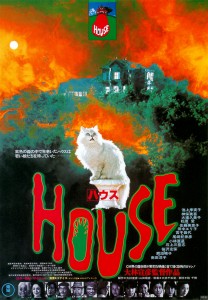Director: Nobuhiko Obayashi
Cast: Kimiko Ikegami, Miki Jinbo, Ai Matubara, Kumiko Oba, Mieko Sato, Eriko Tanaka, Masayo Miyako, Yoko Minamida, Kiyohiko Ozaki, Saho Sasazawa
Running Time: 88 min.
By Martin Sandison
Ten years ago my knowledge of Japanese cult cinema was lacking to say the least. Then the best cinema in Scotland, The Filmhouse, put on a season where I caught 11 movies in two weeks. The titles I watched included Kihachi Okamoto’s Sword of Doom (my favourite Samurai movie), Yakuza Graveyard (which introduced me to the superb Yakuza films of Kinji Fukasaku) and Shunya Ito’s Female Convict: Scorpion.
However, the film that made a big impression on me, which I caught it again on the huge screen at Udine Far East Film Festival, was House, one of the most famous Japanese cult films ever made; every time I see it I can’t believe my eyes. The audience at FEFF was lucky enough to watch the movie in the company of its director, Nobuhiko Obayashi, where he received the Golden Mulberry Lifetime Achievement award.
House is like a film from another world; every aspect of it is combined to make a film so unique that even almost 40 years after it was made, it’s still ahead of its time. For me, visuals are what makes a film truly great, and House has this in abundance alongside its haunting soundtrack.
The plot merely serves as a springboard for the film to lift into the stratosphere, and is very simple. A group of schoolgirls led by Angel (Kimiko Ikegami) decide to spend their summer holidays in Angel’s Aunt’s House up in the mountains, not realizing the house is haunted. Each girl is like a caricature with them being named: Kung Fu (the tough one), Prof (the logical one), Fantasy (the daydreaming one), Mac (the hungry one) and Melody (the musical one). This set up has the girls use their skills (or lack of) against the house.
There are so many standout scenes, psychedelic visuals and insane editing that every frame is interesting and vibrantly alive. Some are creepy and scary, but a quirky sense of humor is evident throughout. One scene features a demon cat’s meow being mixed into the soundtrack that had me in stitches. Others include a disembodied head biting one of the girls; a piano that eats people alive; and a peripheral character with a bucket stuck on his ass. These scenes speak of a singular vision that makes House almost unclassifiable; there really is no other film like it!
Surprisingly, House was director Obayashi’s debut feature (he helmed thousands of commercials before it). The imagination and invention in filmmaking on show belies both facts, so it’s no surprise that Obayashi would become the celebrated director that he is today. Actually, House is just the tip of a very eclectic iceberg in his career; his other films, such as the Manga-based The Girl Who Leapt Through Time and Exchange Students exhibit similar traits to House. Interestingly, most of the actresses playing the lead roles were aged 18-19, and went on to have lucrative careers in Japanese television. Some of them are still working today, especially the lead Ikegami. She plays the role of both Angel and Angel’s mother, shown in some wonderfully, off-the-wall flashback scenes shot in black and white.
Most of the effects are done with painting on the film, creating a visual palette that screams low budget, but is so well done and in-keeping with the “out there” tone of the film – that it works! In fact, everything in House works so well it’s hard to believe. A comparison could be made with Sam Raimi’s The Evil Dead, as both directors had to be insanely creative to keep up with the challenge of a small budget. It’s as if Obayashi wanted to create a microcosm of filmmaking up to the point House was made; there is such a gleeful exploration of cinematic technique and genre tropes that you can’t help but smile and sit in awe of the film’s audacity. The soundtrack, though mostly a repetitive melody, is beautiful and compliments the dream-like imagery of the film.
Many movies transcend genre, but House transcends cinema. I would urge anyone whose interest has been piqued by this review to check it out. It’s a masterpiece.
Martin Sandison’s Rating: 10/10





I LOVE this movie. It’s so wild and weird. House is a tough one to pin down and put into words but you handled the job quite nicely. Well done!
To those who haven’t seen House yet, don’t let the silly effects of the wacko trailer turn you off. Yes, it’s dated and goofy, but it’s also an unforgettable piece of gonzo cinema. Check it out.
Thanks Kyle! I agree!